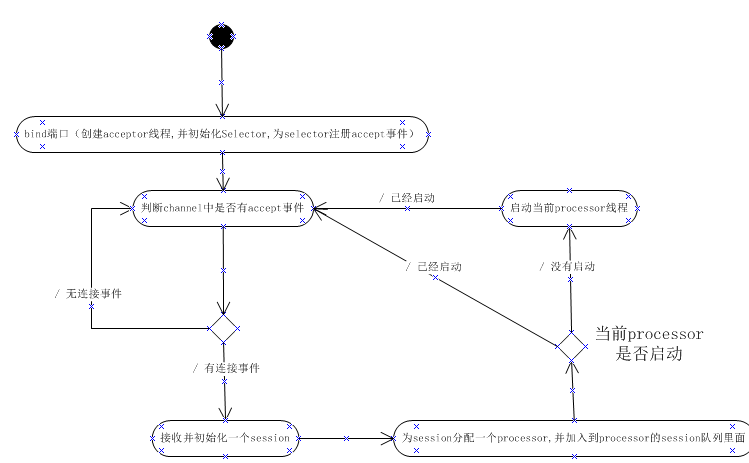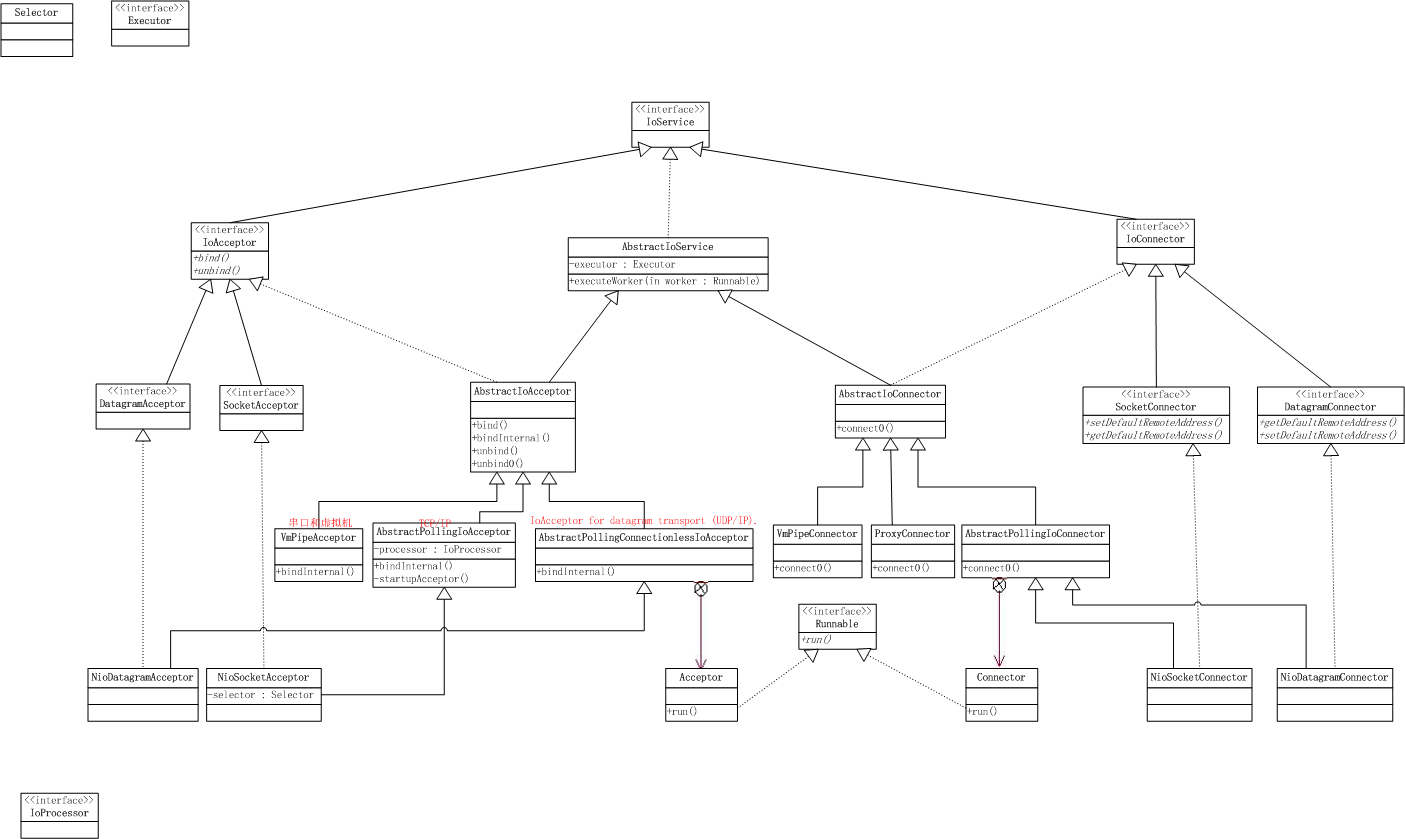UI篇--Android中TableLayout中的布局
Apache MINA 2 是一个开发高性能和高可伸缩性网络应用程序的网络应用框架。它提供了一个抽象的事件驱动的异步 API,可以使用 TCP/IP、UDP/IP、串口和虚拟机内部的管道等传输方式。
首先,mina server端acceptor启动方法:
1、NioSocketAcceptor.bind(InetSocketAddress)或者NioSocketAcceptor.bind(SocketAddress...)方法。
例如:
acceptor.bind(new InetSocketAddress(1234));
mina底层的调用链:
NioSocketAcceptor.bind(InetSocketAddress)-->
AbstractIoAcceptor.bind(SocketAddress localAddress) -->
AbstractIoAcceptor.bind(Iterable<? extends SocketAddress> localAddresses)-->
AbstractPollingIoAcceptor.bindInternal(List<? extends SocketAddress> localAddresses)-->
AbstractPollingIoAcceptor.startupAcceptor()
1、创建线程Acceptor线程-->
acceptor线程启动run()
1、初始化acceptor端的Selector,即NioSocketAcceptor.Selector
2、NioSocketAcceptor.open(SocketAddress localAddress)
// Register the channel within the selector for ACCEPT event
channel.register(selector, SelectionKey.OP_ACCEPT);
acceptor工作流程:

一、IoService类图

如上图所示,IOService层根据不同的角色又分为IOAcceptor(服务端左半部分)和IOConnector (客户端右半部分),分别用于接受连接与请求连接操作。
二、服务端
2.1、IoAcceptor接口
IoAcceptor相当于是对ServerSocketChannel的封装,最重要的两个操作是绑定(解绑)与接受连接,IoAcceptor接口中有多个重载的bind()方法,当然呼应有多个重载的unbind()方法。
public interface IoAcceptor extends IoService {
void bind() throws IOException;
void bind(SocketAddress localAddress) throws IOException;
void bind(SocketAddress firstLocalAddress, SocketAddress... addresses) throws IOException;
void bind(Iterable<? extends SocketAddress> localAddresses) throws IOException;
void unbind();
void unbind(SocketAddress localAddress);
void unbind(SocketAddress firstLocalAddress, SocketAddress... otherLocalAddresses);
void unbind(Iterable<? extends SocketAddress> localAddresses);
}
2.2、IoAcceptor的实现类AbstractIOAcceptor
IoAcceptor其方法的实现在抽象类AbstractIOAcceptor的bind方法中,这个方法在做了参数检查等操作后,将真正的绑定操作交给abstract bindInternal()来完成。对于bindInternal有基于TCP/IP,UDP/IP,VMPipe三种实现类,分别对应
- AbstractPollingIoAcceptor对应TCP/IP
- AbstractPollingConnectionlessIoAcceptor对应UDP/IP
- VmPipeAcceptor对应串口和虚拟机内部的管道
以TCP/IP为例来看绑定过程,见AbstractPollingIoAcceptor.java的源码:
protected final Set<SocketAddress> bindInternal(List<? extends SocketAddress> localAddresses) throws Exception {
// Create a bind request as a Future operation. When the selector
// have handled the registration, it will signal this future.
AcceptorOperationFuture request = new AcceptorOperationFuture(localAddresses);
// adds the Registration request to the queue for the Workers
// to handle
registerQueue.add(request);
// creates the Acceptor instance and has the local
// executor kick it off.
startupAcceptor();
// As we just started the acceptor, we have to unblock the select()
// in order to process the bind request we just have added to the
// registerQueue.
try {
lock.acquire();
// Wait a bit to give a chance to the Acceptor thread to do the select()
Thread.sleep(10);
wakeup();
} finally {
lock.release();
}
// Now, we wait until this request is completed.
request.awaitUninterruptibly();
if (request.getException() != null) {
throw request.getException();
}
// Update the local addresses.
// setLocalAddresses() shouldn't be called from the worker thread
// because of deadlock.
Set<SocketAddress> newLocalAddresses = new HashSet<SocketAddress>();
for (H handle : boundHandles.values()) {
newLocalAddresses.add(localAddress(handle));
}
return newLocalAddresses;
主要做了以下几件事情:
1、将绑定请求放入registerQueue中
2、启动Acceptor,从Acceptor类的run方法可以看到,这一步会阻塞在Acceptor选择器的选择操作中
3、调用wakeup让选择器返回
4、等待请求处理完成,这一步会阻塞在ready变量中,当ready变量为true时才会返回,当接受连接后ready会被设置为true.
现在重点看一下AbstractPollingIoAcceptor$Acceptor的run方法:
public void run() {
assert (acceptorRef.get() == this);
int nHandles = 0;
// Release the lock
lock.release();
while (selectable) {
try {
// Detect if we have some keys ready to be processed
// The select() will be woke up if some new connection
// have occurred, or if the selector has been explicitly
// woke up
int selected = select();
// this actually sets the selector to OP_ACCEPT,
// and binds to the port on which this class will
// listen on
nHandles += registerHandles();
// Now, if the number of registred handles is 0, we can
// quit the loop: we don't have any socket listening
// for incoming connection.
if (nHandles == 0) {
acceptorRef.set(null);
if (registerQueue.isEmpty() && cancelQueue.isEmpty()) {
assert (acceptorRef.get() != this);
break;
}
if (!acceptorRef.compareAndSet(null, this)) {
assert (acceptorRef.get() != this);
break;
}
assert (acceptorRef.get() == this);
}
if (selected > 0) {
// We have some connection request, let's process
// them here.
processHandles(selectedHandles());
}
// check to see if any cancellation request has been made.
nHandles -= unregisterHandles();
} catch (ClosedSelectorException cse) {
// If the selector has been closed, we can exit the loop
break;
} catch (Throwable e) {
ExceptionMonitor.getInstance().exceptionCaught(e);
try {
Thread.sleep(1000);
} catch (InterruptedException e1) {
ExceptionMonitor.getInstance().exceptionCaught(e1);
}
}
}
// Cleanup all the processors, and shutdown the acceptor.
if (selectable && isDisposing()) {
selectable = false;
try {
if (createdProcessor) {
processor.dispose();
}
} finally {
try {
synchronized (disposalLock) {
if (isDisposing()) {
destroy();
}
}
} catch (Exception e) {
ExceptionMonitor.getInstance().exceptionCaught(e);
} finally {
disposalFuture.setDone();
}
}
}
}
(1)、selector被wakeup唤醒后,调用registerHandles方法从registerQueue中取出请求依次调用open方法
private int registerHandles() {
for (;;) {
// The register queue contains the list of services to manage
// in this acceptor.
AcceptorOperationFuture future = registerQueue.poll();
if (future == null) {
return 0;
}
// We create a temporary map to store the bound handles,
// as we may have to remove them all if there is an exception
// during the sockets opening.
Map<SocketAddress, H> newHandles = new ConcurrentHashMap<SocketAddress, H>();
List<SocketAddress> localAddresses = future.getLocalAddresses();
try {
// Process all the addresses
for (SocketAddress a : localAddresses) {
H handle = open(a);
newHandles.put(localAddress(handle), handle);
}
// Everything went ok, we can now update the map storing
// all the bound sockets.
boundHandles.putAll(newHandles);
// and notify.
future.setDone();
return newHandles.size();
} catch (Exception e) {
// We store the exception in the future
future.setException(e);
} finally {
// Roll back if failed to bind all addresses.
if (future.getException() != null) {
for (H handle : newHandles.values()) {
try {
close(handle);
} catch (Exception e) {
ExceptionMonitor.getInstance().exceptionCaught(e);
}
}
// TODO : add some comment : what is the wakeup() waking up ?
wakeup();
}
}
}
}
open方法完成了ServerSocket的绑定和注册(NioSocketAcceptor.open(SocketAddress localAddress)方法如下)
protected ServerSocketChannel open(SocketAddress localAddress) throws Exception {
// Creates the listening ServerSocket
ServerSocketChannel channel = ServerSocketChannel.open();
boolean success = false;
try {
// This is a non blocking socket channel
channel.configureBlocking(false);
// Configure the server socket,
ServerSocket socket = channel.socket();
// Set the reuseAddress flag accordingly with the setting
socket.setReuseAddress(isReuseAddress());
// and bind.
socket.bind(localAddress, getBacklog());
// Register the channel within the selector for ACCEPT event
channel.register(selector, SelectionKey.OP_ACCEPT);
success = true;
} finally {
if (!success) {
close(channel);
}
}
return channel;
}
(2)、从(1)中可以知道selector上注册了ServerSocketChannel的OP_ACCEPT键,注册后nHandles==0,selected==0,进行下一次循环,同样是阻塞在select方法上
(3)、当连接到来时,select方法返回,selected>0,执行processHandles方法
private void processHandles(Iterator<H> handles) throws Exception {
while (handles.hasNext()) {
H handle = handles.next();
handles.remove();
// Associates a new created connection to a processor,
// and get back a session
S session = accept(processor, handle);
if (session == null) {
continue;
}
initSession(session, null, null);
// add the session to the SocketIoProcessor
session.getProcessor().add(session);
}
}
该方法在完成真正的接受连接操作后,创建session并扔到processor中,后续的工作交给processor来完成。每个session中其实有一个SocketChannel,这个socketChannel实际上是被注册到了processor的selector上。注册代码在NioProcessor类中可以找到
总结一下:Acceptor线程专门负责接受连接,在其上有一个selector,轮询是否有连接建立上来,当有连接建立上来,调用ServerSocketChannel.accept方法来接受连接,这个方法返回一个session对象,然后将这个session对象加入processor中,由processor遍历每个session来完成真正的IO操作。processor上也有一个selector与一个Processor线程,selector用于轮询session,Processor线程处理每个session的IO操作。
UI篇--Android中TableLayout中的布局的更多相关文章
- (Android UI)Android应用程序中资源:图片、字符串、颜色、布局等
Android系统设计采用代码和布局分离的设计模式,因此在设计Android应用程序时需要遵循该设计模式. “把非代码资源(如图片和字符串常量)和代码分离开来始终是一种很好的做法.”---<An ...
- UI篇--Android中3种方法实现back键动作
方法一:重写onBackPressed方法 @Override public void onBackPressed() { // do something what you want super.on ...
- UI篇--android实现底部按钮布局
1.采用LinearLayout布局: <LinearLayout android:id="@+id/main" android:layout_width="fil ...
- Android:GridView中实现点击Item变色,再点击还原。
使用GridView时想实现点击其中的一个Item,该Item改变背景,再次点击Item变回原来的背景,网上搜了很多资料都没有看到类似的案例,但还是有所启发,现来分享我的做法. 首先,首先为GridV ...
- Android 自定义View及其在布局文件中的使用示例(三):结合Android 4.4.2_r1源码分析onMeasure过程
转载请注明出处 http://www.cnblogs.com/crashmaker/p/3549365.html From crash_coder linguowu linguowu0622@gami ...
- Android 自定义View及其在布局文件中的使用示例(二)
转载请注明出处 http://www.cnblogs.com/crashmaker/p/3530213.html From crash_coder linguowu linguowu0622@gami ...
- Android studio中的6大布局
1.相对布局代码: <?xml version="1.0" encoding="utf-8"?> <RelativeLayout xmlns: ...
- iOS开发UI篇—在UIImageView中添加按钮以及Tag的参数说明
ios开发UI篇—在ImageView中添加按钮以及Tag的参数说明 一.tag参数 一个视图通常都只有一个父视图,多个子视图,在开发中可以通过使用子视图的tag来取出对应的子视图.方法为Viewwi ...
- iOS开发UI篇—IOS开发中Xcode的一些使用技巧
iOS开发UI篇—IOS开发中Xcode的一些使用技巧 一.快捷键的使用 经常用到的快捷键如下: 新建 shift + cmd + n 新建项目 cmd + n 新建文 ...
随机推荐
- 用django-tinymce搞个富文本编辑器
玩过一圈之后,这些应用慢慢变得简单: 步骤如下: 一,安装: pip install django-tinymce 二,配置APP: INSTALLED_APPS = ( ... 'tinymce', ...
- hdu 4473 Exam 数学
思路: 将条件转化为满足abc<=n的abc的数目. 1.3个数相等时,为 A; 2.有2个数相等时,为 B; 3.都不相等时,为 C. 则结果为A+3*B+6*C. 代码如下: #includ ...
- Oracle 体系结构2 - 实例和数据库
Oracle最最基本的概念: 实例和数据库 实例就是oracle进程和一块共享内存, 数据库就是静态的文件,如datafile, log file, redo logfile, control fil ...
- Oracle - 位图索引的适用条件
位图索引的适用条件 位图索引适合只有几个固定值的列,如性别.婚姻状况.行政区等等,而身份证号这种类型不适合用位图索引. 位图索引适合静态数据,而不适合索引频繁更新的列. 举个例子,有这样一个字段bus ...
- java打印时间精确到毫秒
package net.floodlightcontroller.conflict; import java.io.*; import java.util.*; import java.text.Si ...
- 小心!#define max(a,b) a>b?a:b
今天做oj的时候,定义了两个宏: //wrong code#define max_2(a,b) a>b?a:b #define max_3(a,b,c) (a>b?a:b)>c?(a ...
- Highcharts中初始化最大值与最小值的柱状图
<!doctype html> <html lang="en"> <head> <script type="text/javas ...
- lintcode:哈希函数
题目: 哈希函数 在数据结构中,哈希函数是用来将一个字符串(或任何其他类型)转化为小于哈希表大小且大于等于零的整数.一个好的哈希函数可以尽可能少地产生冲突.一种广泛使用的哈希函数算法是使用数值33,假 ...
- 包装类型的比较,如:Integer,Long,Double
Integer, Long, Double等基本类型的包装类型,比较时两种方法:第一种:equals, 第二种: .intValue(), .longValue() , .doubleValue ...
- Android:查看应用创建的数据库
每个Android应用程序都可以使用SQLite数据库.它创建的位置在data/data/<项目文件夹>/databases/ 运行后打开,window->show view-> ...
